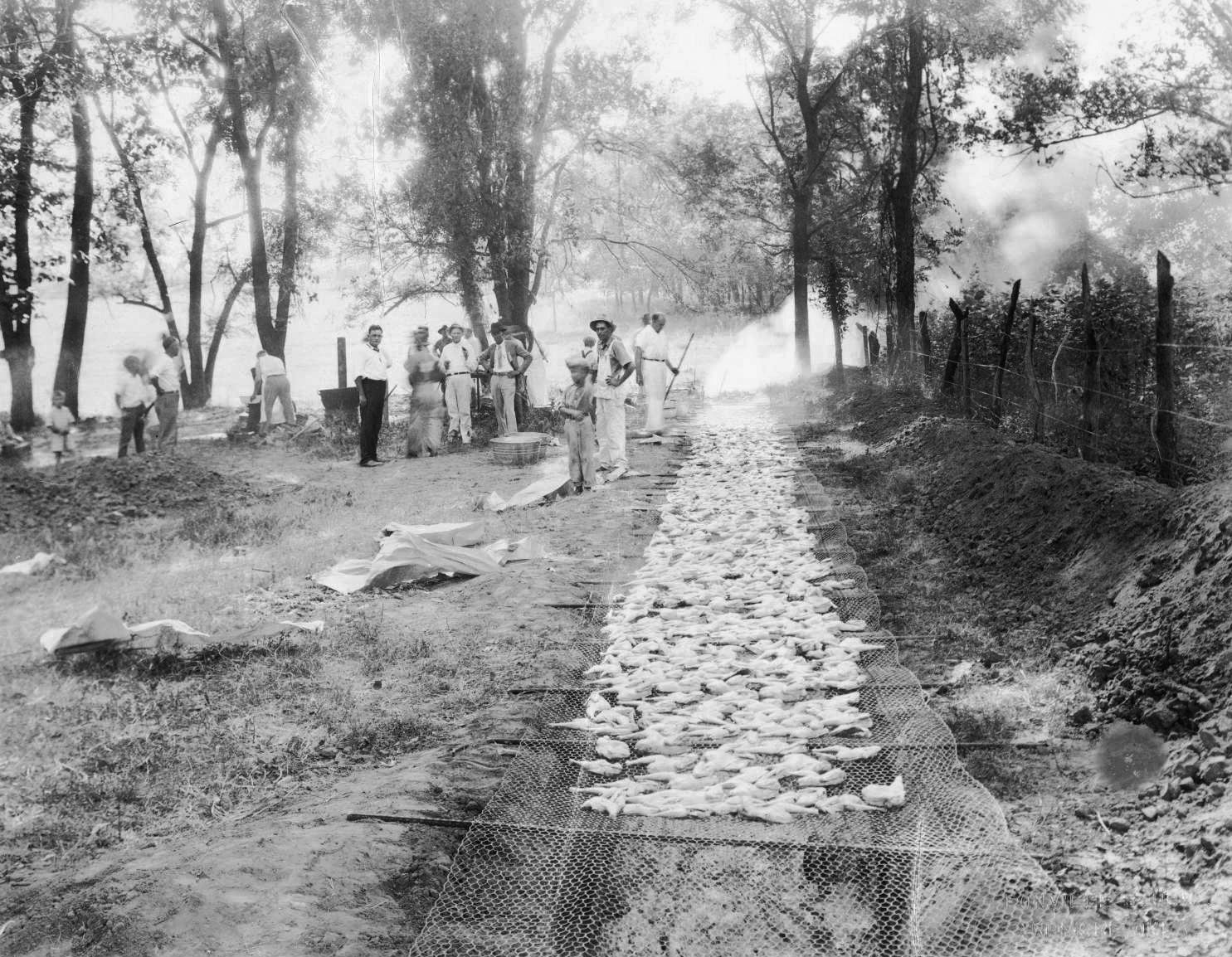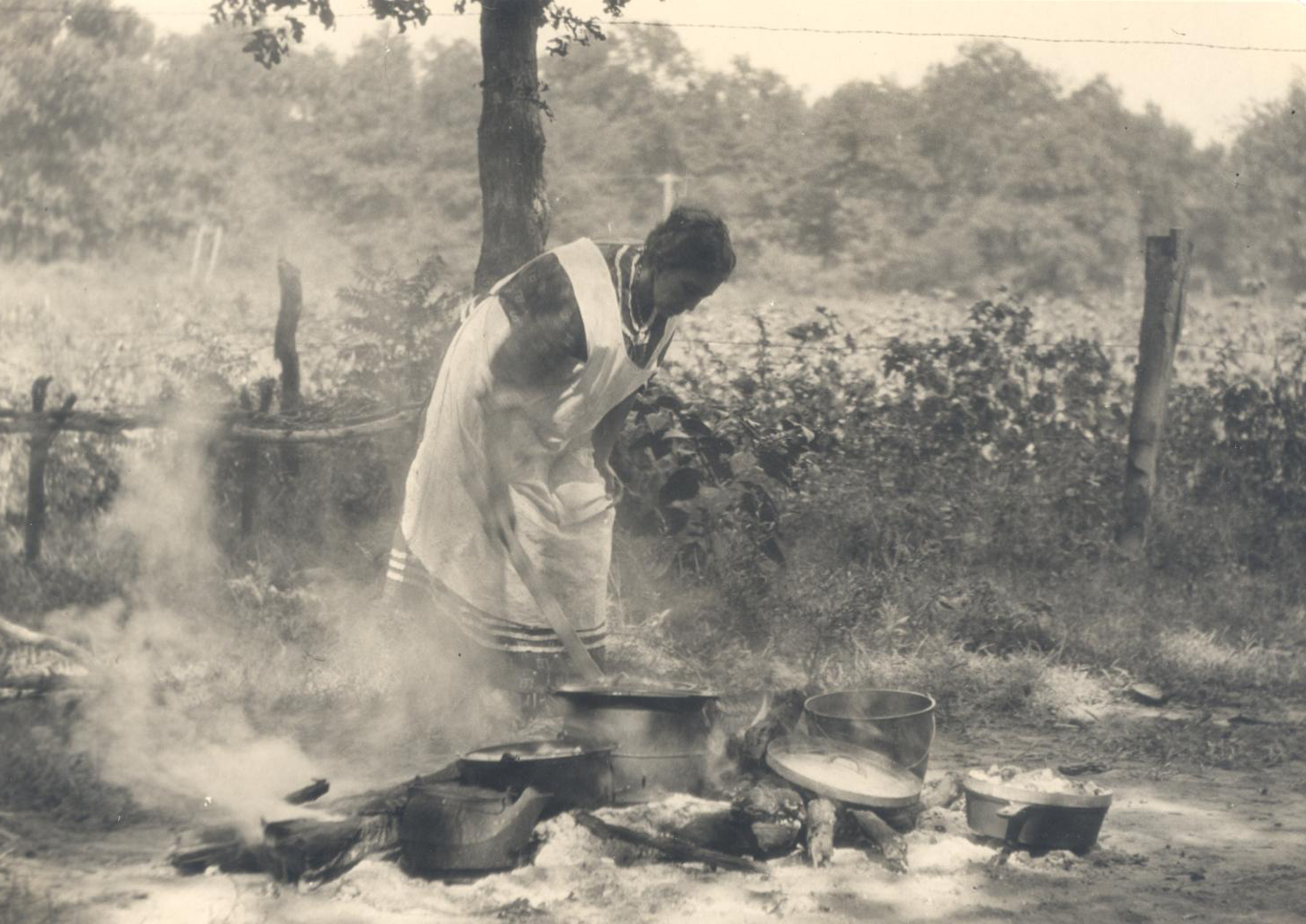FOODWAYS.
As in other aspects of culture, Oklahoma's foodways are the product of the state's special history and its location at the convergence of geographic regions. The state's American Indian population is large and heterogeneous, composed of peoples whose ancestors have resided in the state since time immemorial and others who were forced to relocate there from homelands as diverse as New York and California. African American settlement has followed two paths. Many African Americans came to Indian Territory in the company of the Indian nations of the Southeast. Whether slaves or free citizens, these populations lived in two worlds at once, participating in their own communities and as functioning members of American Indian societies. A second wave of African American settlement began after the Civil War and continued into the early twentieth century. Both the Southeastern Indian peoples and the African Americans who settled in Oklahoma possessed food habits rooted in the Deep South of the seventeenth and eighteenth centuries.
Then and there, Africans, Natives, and Europeans interacted in a complex frontier society to which all three contributed features of what is today recognized as "southern" foodways. Europeans contributed items such as salt pork and flour breads to this tradition, and Africans introduced old-world dishes such as fried chicken, sweet potatoes, and okra. At the base of this new cuisine were staples long domesticated by American Indians before 1492—beans, squash, and most importantly, corn in myriad forms.
Not long after southerners of Native and African heritage began arriving in present Oklahoma, European Americans from the region followed them, once again crowding in upon those whom they had displaced. The result of these mixings and migrations is the presence, in Oklahoma, of southern foodways, often with a highly Southeastern Indian quality. Today, when Southeastern Indian communities hold "wild onion dinners" to raise funds for their community organizations, they typically attract their non-Indian neighbors in great numbers. Diners, whatever their heritage, share a love of the foods highlighted in such events: beans, greens, grape dumplings, fried pork, corn soup, cabbage, potato salad, and other dishes found throughout the south. Non-Indian Oklahomans of southern origin are also more likely than their fellows from elsewhere to understand and appreciate such Southeastern Indian dishes as sofkey and kunuhchee (a drink made from pounded hickory nuts).
While eastern Oklahoma's traditional tastes are southern, movement west across the state brings increasing influence from Anglo traditions of the Midwest and Great Plains that have more diffuse origins. Plains Indian peoples continue to appreciate the foods of their ancestors, but unlike Native easterners, these are unlikely to be known by non-Natives. The importance of ranching and its complex mixture of old Anglo and Hispanic customs have left an impact on Oklahoma foodways, most obviously in the prominence of beef. Chicken fried steak, a statewide favorite, stands as a symbol of Oklahoma's dietary heritage. The method of cooking is southern, ultimately African, in origin, while the food itself is a product of Oklahoma's western heritage. Not all foods loved by Oklahomans are self-conscious symbols, though. Few Oklahomans recognize the histories of much that they eat. The mid-twentieth-century home economics movement taught Oklahomans to appreciate new foods that now seem old fashioned. Jell-O salads, widely popular on the Great Plains, provide one example.
As the twentieth century progressed, this complex historic, ethnic, and geographic picture began to be enriched further through new waves of immigration. Unlike the settlement pattern adopted by their predecessors, this more recent migration to Oklahoma has an urban focus. Among these new immigrants are people of Middle Eastern backgrounds. They have introduced their ethnic foodways to both Oklahoma City and Tulsa; Lebanese falafel restaurants compete for customers who are dining out more often. In Oklahoma City a large urban district is home to a variety of communities of Southeast Asian origin. Vietnamese, Chinese, and Thai restaurants and grocery stores serve patrons from these communities and a broader clientele passionate about food and cosmopolitan in its tastes. Throughout the state, Mexican food and foodways have become pervasive as the state's Mexican American population rapidly grows. These trends and Oklahoma's embracing of varied ethnic foodways reflect national patterns, but they would have surprised the nineteenth century migrants—African, Native, and European—who settled Indian and Oklahoma territories and gave Oklahoma its culinary identity. The lesson to be learned from this history of eating is that change is the only constant in the ways Oklahomans eat, despite the loyalty they feel towards their favorite dishes and their grandmothers' recipes.
See Also
BARBECUE, CHILI, CHICKEN-FRIED STEAK, FOLKLIFE, FRY BREAD, MOONSHINE, SOFKEY, STATE MEAL, WILD ONION DINNERS
Bibliography
Jack D. Baker, comp., and Jack Gregory and Rennard Strickland, eds., Cherokee Cookbook (Fayetteville, Ark.: Indian Heritage Association, 1968).
Deb Bennett and Robert S. Hoffman, "Ranching in the New World," in Seeds of Change: A Quincentennial Commemoration, ed. Herman J. Viola and Carolyn Margolis (Washington, D.C.: Smithsonian Institution Press, 1991).
Robert T. Hall, "Savoring Africa in the New World," in Seeds of Change: A Quincentennial Commemoration, ed. Herman J. Viola and Carolyn Margolis (Washington, D.C.: Smithsonian Institution Press, 1991).
Jason Baird Jackson, "Architecture and Hospitality: Ceremonial Ground Camps and Foodways of the Yuchi Indians," The Chronicles of Oklahoma 76 (Summer 1998).
Joe Gray Taylor, "Foodways," in Encyclopedia of Southern Culture, ed. Charles Reagan Wilson and William Ferris (Chapel Hill: North Carolina Press, 1989).
Gerald Wofford, "Got Kun-nah-chee?" Oklahoma Indian Times 6 (2000).
Citation
The following (as per The Chicago Manual of Style, 17th edition) is the preferred citation for articles:
Jason Baird Jackson, “Foodways,” The Encyclopedia of Oklahoma History and Culture, https://www.okhistory.org/publications/enc/entry?entry=FO014.
Published January 15, 2010
© Oklahoma Historical Society





